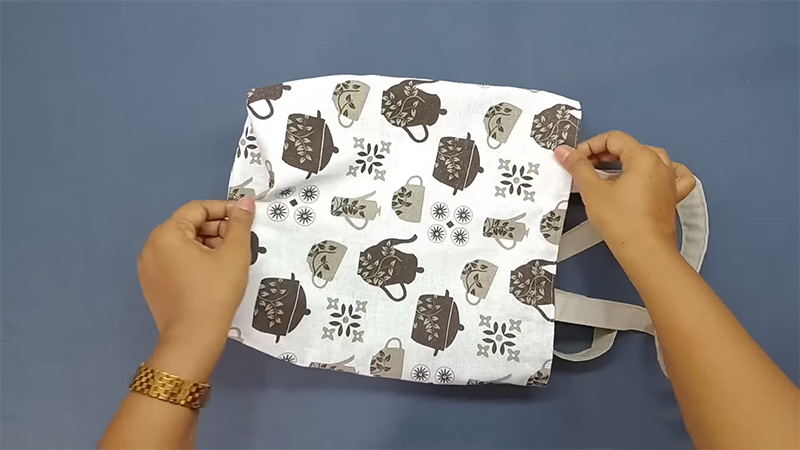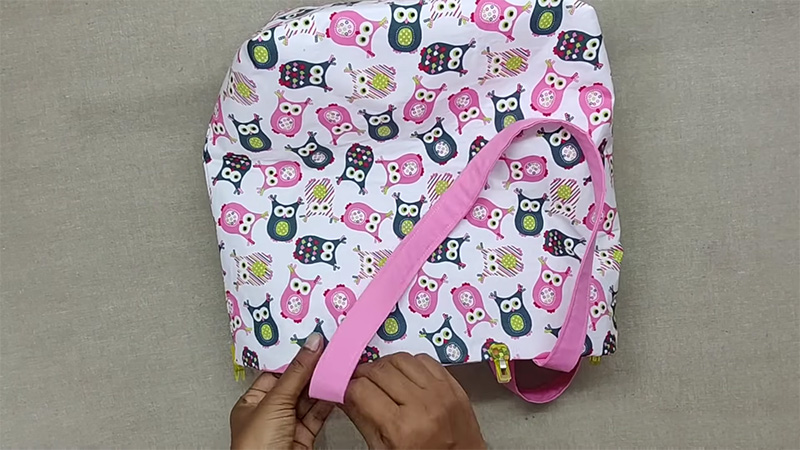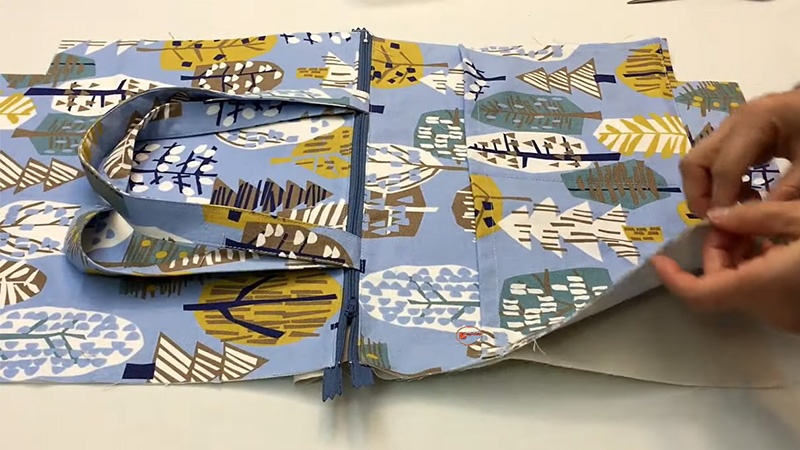A well-crafted tote bag is not just a fashion statement; it’s a versatile accessory that combines functionality with style. If you’re ready to dive into a rewarding sewing project, creating your own tote bag with a lining is an excellent choice.
Whether you’re a seasoned sewer or a beginner eager to enhance your skills, this guide will lead you through each step with clear instructions and tips to make the process enjoyable and satisfying.
In this comprehensive tutorial, we’ll teach you how to sew a tote bag with lining. With a lined interior, your tote will be sturdy enough to carry your daily essentials, groceries, or even your latest sewing project.
So, choose your favorite fabrics, thread your sewing machine, and let’s embark on this creative journey to craft a tote bag that perfectly matches your personal style. Your new handmade tote is just a few stitches away!

How to Sew a Tote Bag with Lining?
Creating a tote bag with lining is a satisfying sewing project that combines style and functionality. Here’s a step-by-step guide to help you sew your own tote bag.
Prepare Your Fabric
Wash, dry, and press your fabrics to remove any wrinkles and shrinkage. If using interfacing, follow the manufacturer’s instructions to attach it to the wrong side of your exterior fabric pieces.
Cut the Fabric
Cut two identical rectangles from your exterior fabric for the front and back of the tote. Cut two identical rectangles from your lining fabric for the lining of the tote. These rectangles should be the same size.
Create the Straps
Cut two long strips from your exterior fabric for the straps. The width and length of the straps can vary depending on your preference, but a common size is about 2-3 inches wide and 20-25 inches long.
Fold each strap in half lengthwise with right sides together and sew along the long edge, leaving the ends open. Turn the straps right side out, press them flat, and set them aside.
Prepare the Lining
Lay the lining fabric pieces right sides together. Pin or clip along the sides and bottom, leaving the top edge open. Sew along the sides and bottom using a ½ inch seam allowance. Leave the top edge open.
Box the Corners
To create depth at the bottom of the tote, pinch each bottom corner of the lining so that the side seam aligns with the bottom seam.
Measure and mark a line about 2 inches from the point and sew across the line. Trim off the excess fabric. Repeat this step for the exterior fabric as well.
Attach the Straps
Position the straps on the exterior fabric, about 2-3 inches from each side seam. Ensure they are centered and facing down into the bag. Pin or clip them in place. Baste the straps in place by sewing across the top edge with a long stitch.
Assemble the Tote
Place the exterior fabric piece right side up on your work surface. Lay the lining piece right side down on top of it, aligning the top edges and sides. Pin or clip the top edges together, including the straps.
Sew the Top Edge
Sew along the top edge of the tote, about ½ inch from the edge, leaving a 4-5 inch opening for turning. Backstitch at the beginning and end of the stitching.
Turn the Tote
Carefully turn the entire tote right side out through the opening in the lining. Push out the corners to create a neat shape.
Close the Lining Opening
Fold the raw edges of the lining opening inside and hand-stitch it closed using a blind stitch or ladder stitch.
Press and Finish
Give your tote a final press to smooth out any wrinkles and give it a polished look.
Your tote bag with lining is complete! This versatile accessory is ready to carry your belongings in style. You can customize it with different fabrics and sizes to suit your needs and personal style. Enjoy your handmade creation!
What Materials Are Used for Sewing Tote Bag?

When sewing a tote bag, you’ll need a variety of materials to create a sturdy and stylish accessory. Here’s a list of the essential materials used for sewing a tote bag:
Exterior Fabric
Choose a durable and visually appealing fabric for the outside of your tote bag. Common choices include cotton, canvas, denim, linen, or even upholstery fabric, depending on your desired style and purpose.
Lining Fabric
The lining fabric adds a finishing touch to the interior of the tote. Opt for a lightweight cotton fabric or a material that complements the exterior fabric.
Interfacing (Optional)
Interfacing provides structure and stability to your tote bag. It’s especially useful for lightweight or flimsy fabrics. You can choose fusible or sew-in interfacing, depending on your preference.
Thread
Use high-quality, matching thread for both sewing the seams and topstitching. Strong thread ensures the durability of your tote bag.
Sewing Machine
A sewing machine with a straight stitch and zigzag stitch capability is essential for sewing the seams and finishing edges neatly. Sharp fabric scissors are crucial for cutting your fabric accurately and cleanly.
Ruler or Measuring Tape
You’ll need these tools to measure and mark fabric for cutting and folding, especially when creating straps and pockets. Ironing is a critical step in sewing, helping to remove wrinkles and set seams for a professional finish.
Fabric Marker or Chalk
These tools are handy for marking cutting lines, stitching lines, or placement for straps and pockets.
Straps (optional)
You can create straps using the same fabric as your tote or purchase pre-made straps for convenience. Depending on your design, you may want to add a closure like a magnetic snap, button, or zipper.
Decorative Elements (optional)
Consider adding decorative elements like appliqué, embroidery, or fabric paint to personalize your tote bag.
These materials will help you create a well-constructed tote bag that suits your style and functional needs.
Be sure to choose fabrics and colors that match your taste and purpose, whether it’s for everyday use, shopping, or as a stylish accessory.
Different Ways to Add Lining to a Tote Bag

Adding a lining to a tote bag not only enhances its durability but also gives it a polished and finished look. Here are different ways to add a lining to your tote bag:
Drop-In Lining
This is one of the simplest methods. You create the exterior of your tote bag and the lining as separate pieces. After sewing both pieces, you drop the lining into the exterior, align the top edges, and then sew around the top to attach them together.
Fully Lined Tote Bag
With this method, you sew the exterior and lining separately but leave an opening in the lining. After sewing the exterior, sew the lining together, right sides facing, and leave a small section unsewn.
Turn the exterior right side out and place it inside the lining. Sew around the top edge, and then pull the bag through the opening you left in the lining to turn it right side out.
Semi-Finished Lining
This technique involves attaching the lining to the exterior at the top edge and side seams but leaving the bottom unattached. It gives the appearance of a lining without sewing the bottom seams together. This is often used in reversible tote bags.
French Seam Lining
A French seam is a neat way to enclose raw edges. In this method, you sew the exterior and lining with wrong sides together first, press the seam open, then fold the exterior over the lining, enclosing the seam, and sew again. This creates a clean and finished look.
Boxed Bottom Lining
To create a squared-off bottom for both the exterior and lining, you sew the corners of the exterior and lining separately to create boxed corners before attaching the lining to the exterior.
Zippered Lining
If you want an extra secure lining, you can add a zipper to the top of the lining fabric before attaching it to the exterior. This can be especially useful for tote bags used for travel or to carry valuable items.
Divider Pockets
You can add divider pockets to your lining to help organize the contents of your tote bag. These can be slip pockets, zippered pockets, or even divided sections within the lining.
The choice of lining method depends on your sewing skills, the look you want to achieve, and the functionality of your tote bag. Each method has its advantages, so pick the one that best suits your project and sewing expertise.
FAQs
While interfacing isn’t strictly required, it can enhance the structure and durability of your tote bag, especially if you’re using lightweight fabrics. It’s a good option to consider for a sturdier bag.
Yes, you can create a reversible tote bag with a lining by sewing both the exterior and lining as separate bags and then sewing them together at the top edge.
This allows you to use the tote with either side facing out.
A zippered lining provides extra security for your belongings. It’s ideal for tote bags used for travel or as a purse, as it helps prevent items from accidentally falling out or being accessed by others.
Divider pockets can help keep your tote bag organized. Be sure to measure and sew them accurately, ensuring they are evenly spaced and securely attached to the lining fabric.
Yes, you can add a lining to a pre-made tote bag, although it may require some seam-ripping and hand sewing.
You’ll need to carefully open the seams of the bag, insert the lining, and then sew the top edge to secure it.
Conclusion
Sewing your own tote bag with a lining is a fulfilling and rewarding project that allows you to create a stylish and functional accessory tailored to your preferences.
Throughout this tutorial, you’ve learned valuable skills, from selecting fabrics to adding a lining for extra durability and flair.
As you hold your finished tote bag in your hands, take pride in the craftsmanship and creativity you’ve poured into it. Your new tote is more than just a bag; it’s a reflection of your unique style and sewing expertise.
You can adapt this project by experimenting with different fabrics, sizes, and design elements to craft a collection of one-of-a-kind tote bags for various occasions.
So, keep those creative juices flowing, explore new sewing projects, and carry your handmade tote with pride, knowing that you’ve mastered the art of sewing while crafting a stylish accessory that’s both functional and fashionable. Happy sewing!
Leave a Reply